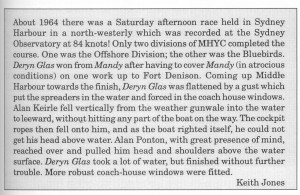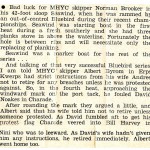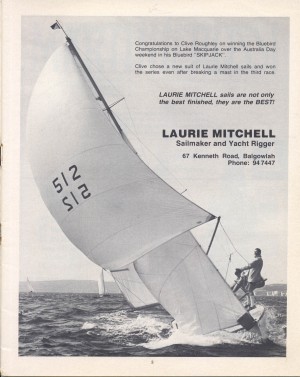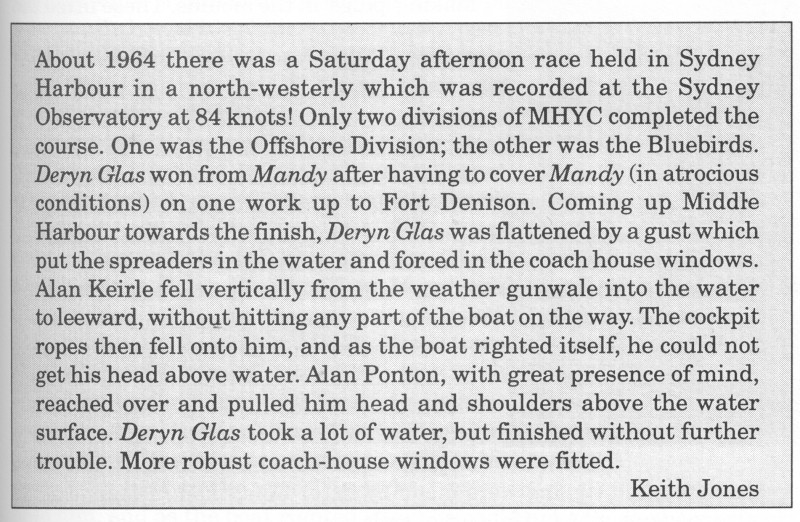| Bluebird | |
|---|---|
 Deryn Glas (Keith Jones) on Sydney Harbour in 1966 | |
| Rig Type | 3/4 |
| LOA | 6.7m, 22f |
| Beam | 2.24m, 7.34f |
| Draft | 1.17m, 3.83f |
| Website | www.bluebirdsailing.org.au/ |
| Designer | Ken Watts |
| Year Designed | 1947 (age 77) |
Bluebird
Introducing the Bluebird (from the Bluebird website in info panel)
The Bluebird is a compact keelboat: 22ft long with four berths.
Known for their robust construction and affordable price tag, the Bluebird makes for an ideal first yacht while still holding enormous attraction for anyone, including seasoned yachties, who enjoy the thrill of competitive class racing or simply a safe cruise.
The Bluebird has been responsible for teaching many sailors about sailing techniques and tactics. In fact, under experienced hands, the class can give larger keel boats with more modern designs a run for their money. It is also an economical alternative to getting into sailing - it doesn't have to cost you the earth to own and sail a keel boat.
History | History (from the Bluebird website in info panel)The Bluebird was designed by Sydney ship building engineer, the late Mr Ken Watts and first appeared in the September 1947 edition of 'Seacraft' as study plans. Mr Watts conceived 'Bluebird' during the war years when he pondered the sort of affordable yacht he could build after wars end. The concept was for a small low cost family keel yacht for amateur construction in plywood. Ken Watts never actually built one for himself, but went on to design other yachts including the popular Daydream. The first two Victorian 'Bluebirds' were launched in 1948 and sailed at Sandringham Yacht Club. Later that year the first N.S.W Bluebird was launched while several more were at various stages of construction. One of the pioneers in plywood yacht construction in Australia, they quickly became popular in all states. As their good performance under sail was recognised, they soon doubled as racing yachts and by the late 1950s racing fleets began forming at various clubs around Australia. By the early 1960s, their extreme popularity lead to their production in fibreglass and hundreds were also built in this medium to the same basic measurements. In the 1964 N.S.W. championships, fibreglass yachts dominated and they continued to be virtually mass produced until well into the 1970s. Through those decades their claim to being "Australia's Peoples Yacht" was never disputed and many thousands of sailors began their keel boat sailing in them. The Victorian Bluebird Association has been active since the 1960s. Today's fleet is mainly based at Royal Yacht Club of Victoria and Hobsons Bay Yacht Club where both Summer and Winter regattas still attract double figures and the competition is fierce. Those that sail them today consider them as relevant as they ever were and pre-loved boats are in demand. |
Bluebirds at MHYC |  Deryn Glas (Keith Jones) on Sydney Harbour in 1966  The Bluebirds were a powerful force at MHYC by Keith Jones The Early Years MHYC: The First 60 Years Article by: Keith Jones Published: 1999 The Bluebirds were a Powerful Force at MHYC In the mid-1960s the Bluebird Division was a powerful force in Middle Harbour Yacht Club. In 1964, MHYC had 37 starting regularly on a scratch start. Cruises were made to further flung yacht clubs for the state title series. Bluebirds went as far as Port Stephens - perhaps further. At least one Bluebird competed with the Junior Offshore Group. In 1961 I bought a 22-foot Bluebird-class yacht. It was purchased as a fibreglass shell and delivered using a truck from Firefighting Equipment 'commandeered' by Alan Keirle to 22 Lavoni Street. Ateam of friends carried the shell up the front lawn where it was set up on a concrete patio built for the purpose. I named it Deryn Glas, which is Welsh for bluebird. Timber interior fittings, bulkheads and so on were built over a two-year period. My late cousin, Les Atkins, a carpenter and cabinet maker, was of great assistance. Others who were to form the crew - Bev Bashford, Alan Keirle, Alan Ponton, Alan Underwood, Peter Polman and Vic Halloran -contributed time and labour. In late 1963, having missed the start of the season, Deryn Glas was taken to Clontarf where John Jeffress fitted the cast-iron keel. When collected from the foundry the keel was over 100 pounds too light. To compensate for this, the lead ballast, put in the bilge for compliance with the waterline measurement, was removed. Plaster of Paris moulds in boxes of sand were made. John MacCallum assisted Alan Ponton melting the lead and making 'plugs' in the moulds. These fitted the appropriate areas very well and added to the yacht's stability. The aim of reducing windage was taken into account when building the cabin hatch and other deck fittings. The main sheet hawse was designed with a curve to encourage the mainsheet to be more central when on a wind, but to run out towards the gunwales when running. There had been stories of Bluebirds having trouble rounding up on spinnaker shy runs. For that reason I took the plan's rudder design and enlarged it significantly in all directions. It also had a beautiful aerofoil cross-section and a square, non-breakaway edge along its bottom. The mast and rigging were made by Peter Cole, then in Marrickville. He also made us a beautiful suit of sails. Deryn Glas was launched on 16 November 1963 (the day on which in the President Kennedy's assassination was reported in Australia). From the first moment putting the yacht hard on the wind, it was evident to me that we had something exceptional. She was beautifully balanced, responsive to the helm and a sheer delight to sail. This was proven subsequently when a number of other skippers won races in the yacht, on occasions when I was unavailable. The first start was a Wednesday afternoon race (in days when a larger fleet turned out than today). Deryn Glas won on handicap. The first start in the Bluebird Division resulted in a third place in the scratch start event. She went on to win the Autumn Point Score of 1963/64. The Bluebird Division of those days provided great racing. The little boat could be used for racing, day sailing and even holidays aboard. Accommodation aboard was cramped and on Deryn Glas we used a boom cover which allowed greater use of the cockpit and even allowed that area to be used as the galley when anchored. We customarily spent a week or more aboard at Cowan Creek just before Christmas each year - two adults, three children and a dog! Bluebird Division racing was great, with Ron Ewen (Karalee II) being champion in the early 60's. Tim Wilson was very competitive but departed for greater things in mid-1960. Toni Redstone (Mandy) was always to the fore. He went on to win a World Title in the Thunderbird class in California. Albert Byrom (Erps Kwerps) was great in light Weather. Doug Brooker built a timber Bluebird with a lead keel in the mid-1960s, and although he acquitted himself very well, the craft could not always pace the fibreglass version. Other famous Bluebird names were Bill Liddell, David Noakes and Hewan Greenwood, who was exceptionally good. There are several still racing with MHYC - Keith Poole and Ben Nossiter for example. John Conroy Snr commenced sailing at an advanced age and went through some traumas in his early learning period, but tenaciously honed his skills to become the best Bluebird sailor in the Division in Lotchen III in the late 1960s and early 1970s, with the aid of his son, John Conroy Jnr, who still sails with MHYC. About 1964 there was a Saturday afternoon race held in Sydney Harbour in a north westerly which was recorded at the Sydney Observatory Weather Bureau at 84 knots! Only two divisions of MHYC completed the course. One was the Offshore Division. The other was the Bluebirds. Deryn Glas won from Mandy after having to cover Mandy (in atrocious conditions) on one Work up to Fort Denison. Coming up Middle Harbour towards the finish, Deryn Glas was flattened by a gust which put the spreaders in the water and forced in the coach house windows. Alan Keirle fell vertically from the weather gunwale into the water to leeward, without hitting any part of the boat on the Way. The cockpit ropes then fell onto him, and as the boat righted itself, he could not get his head above water. Alan Ponton, with great presence of mind, reached over and pulled him head and shoulders above the water surface. Deryn Glas took a lot of water, but finished without further trouble. More robust coach-house windows were fitted. Deryn Glas won only one state title, in 1966, though she was placed in five. (Difficulty beating Gerry Garrett of RPAYC was the problem.) She won a total of 134 races. 1972 was the last state title in which she competed, coming third. Adendum (2016) Other Bluebirds racing competitively included Karolee II- Ron Ewen Mandy - Tony Redstone Gary Jarrett - who was a problem to beat. |
Articles and Pictures | Seacraft April 1966 Middle Harbour Yacht Club - Seawind (Norm Brooker) rammed by out of control Bluebird Middle Harbour Regatta 1972 Middle Harbour Regatta 1972 - Skipjack Clive Roughley
Congratulations to Clive Roughley* on winning the Bluebird Championship on Lake Macquarie over the Australia Day Weekend in his Bluebird SKIPJACK. Clive chose a new suit of Laurie Mitchell sails and won the series even after breaking a mast in the third race. * Clive won a couple of state titles |



